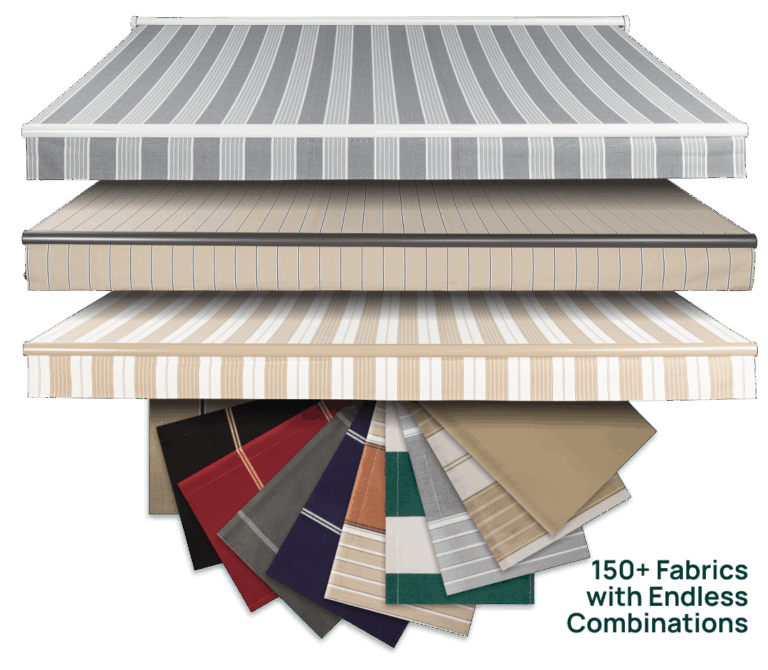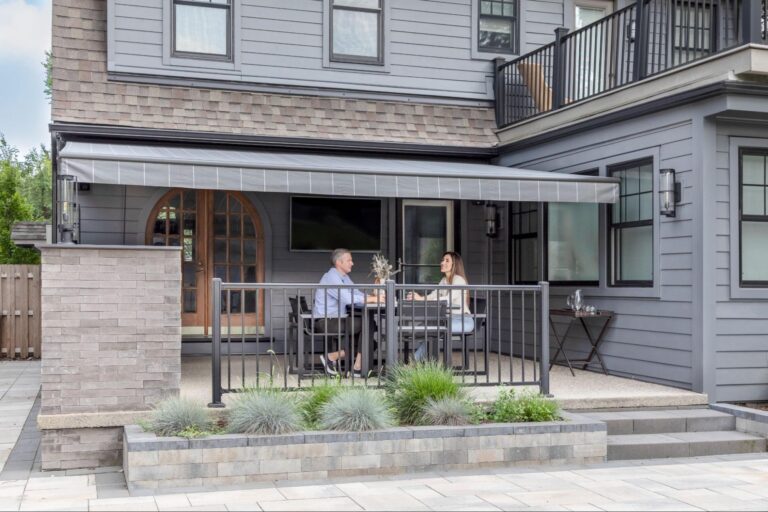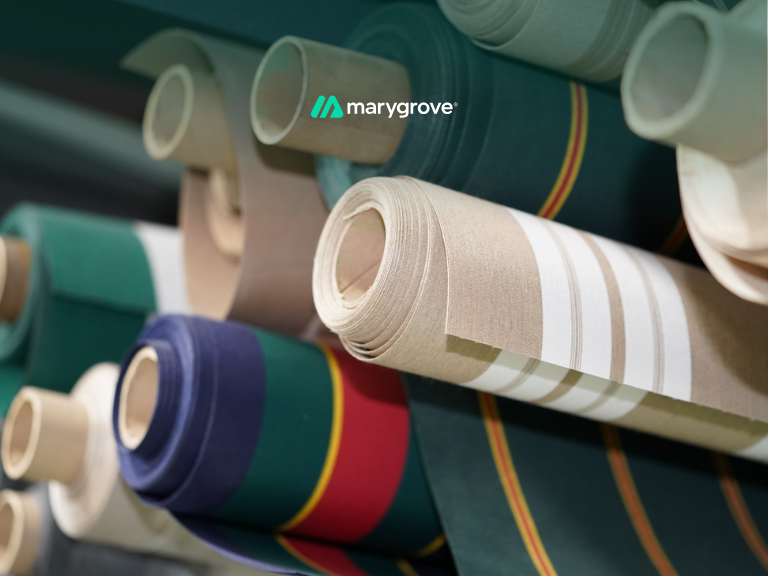The best awning color complements your home’s architecture, matches existing features, balances light and heat, and suits your lifestyle. Neutrals add versatility, bolds create impact, and future planning ensures your awning feels timeless instead of temporary.
How the Right Awning Color Transforms Comfort, Curb Appeal, and Value
The right awning color enhances curb appeal, comfort, and home value, making your outdoor space feel like an intentional extension of your home. Here are the essentials to get it right:
- Match architecture: Traditional homes work best with navy, forest green, or muted neutrals, while modern designs shine with bold hues or clean solids.
- Coordinate with features: Tie the awning into your siding, trim, roofing, and even landscaping to create cohesion.
- Think lifestyle: Blues calm, greens blend, reds energize, pick tones that reflect how you’ll use the space.
- Plan ahead: Consider repainting projects, furniture updates, and even HOA rules that may limit color options.
The right color choice can turn an awning from a utility item into a design feature that elevates your whole home.
While these essentials set the foundation, the details make the difference.
Continue reading to explore deeper insights, avoid common pitfalls, and ensure your awning color remains a source of pride for years to come.
Why Your Awning Color Is More Than Just a Shade Choice
Do check out this review where Buddy Valastro shows how awnings beautifully match home style.
Installing an awning instantly makes your outdoor space more livable.
It blocks harsh sunlight, cools your patio, and creates a comfortable retreat. But the impact goes beyond comfort.
The color of your awning plays a major role in how your home looks, feels, and even how it is valued.
1. Awnings as a Design Feature
Your awning is not just a cover, it is part of your home’s design.
A soft neutral can blend quietly into your exterior, while a bold hue can frame your patio and create a statement.
In either case, the color choice transforms the awning from a utility item into an architectural feature.
2. The Link Between Color and Value
Color influences daily enjoyment as well. A good match can highlight trim details, echo landscaping tones, and boost curb appeal.
Homeowners who rush this decision often regret it, finding that while their awning works well for shade, the color feels mismatched and distracting.
3. Why Thoughtful Choices Matter
Those who carefully align their awning with their home often say it “feels like it belongs.” Instead of sticking out, it ties the design together and elevates the whole property.
Choosing the right color is about creating harmony between function and style. Now let’s explore the most important factors to consider before deciding on your awning’s shade.
What to Consider Before You Pick Your Awning Color

Explore Marygrove Fabric & Frames
Choosing the right awning color is not about guessing which swatch looks good in the showroom.
It is about balancing architecture, lifestyle, and durability so your outdoor space feels complete. Here are the factors that matter most.
1. Match Your Home’s Architecture

Your home’s style sets the foundation for a successful color choice. An awning should enhance that character rather than fight against it.
- Traditional homes pair beautifully with navy, forest green, or muted neutrals.
- Modern homes thrive on bold hues, clean solids, and sharp contrasts.
- Cottage or coastal homes welcome softer tones or playful striped designs.
- Southwestern or stucco homes work best with warm browns and earthy reds.
This choice becomes even more noticeable on visible areas like decks and patios, where the awning is part of the everyday view.
When your awning reflects the language of your architecture, it looks intentional, not like an add-on.
2. Coordinate With Existing Features
Every home has elements that dictate how an awning color will read once installed. Matching or complementing these features is key.
- Siding, shutters, and trim provide a base palette for your awning choice.
- Roof colors often work better as anchors than siding for contrast.
- Stone accents and landscaping tones can inspire natural fabric choices.
- Poolside and patio furniture colors help tie outdoor living areas together.
Whether you are hosting a summer gathering or enjoying quiet personal time outdoors, the right coordination makes the space feel cohesive.
Coordinating with what already exists creates visual harmony and boosts curb appeal.
3. Considering Seasonal Light and Weather Exposure
Where your awning is placed determines how its color will look and last.
- East-facing awnings catch soft morning light that can make colors appear brighter.
- West-facing spaces see harsh evening sun, which can intensify fading in bold fabrics.
- Northern exposures often keep colors cooler and more muted throughout the day.
- Areas with heavy rain or snow may show water marks more on darker shades.
Factoring in light direction and local weather ensures your awning color stays consistent and vibrant through the seasons.
4. Lifestyle, Mood, and Patterns
How you plan to use your space should guide your palette. Color sets the mood for daily experiences.
- Blues calm and soothe, ideal for reading or poolside relaxation.
- Greens blend with gardens, creating a sense of natural escape.
- Reds and oranges energize patios built for lively gatherings.
- Stripes and patterns add flair while hiding debris, but can overwhelm small spaces.
From poolside afternoons to evening meals under the awning, these choices shape how the space feels in everyday use.
Choose colors that support how you want to live under your awning, not just what looks trendy.
5. Plan for the Future
An awning is a long-term investment, so it should evolve with your home.
- Exterior repainting may shift how a bold awning looks over time.
- Neutrals adapt easily to new furniture or landscape updates.
- Color restrictions from HOAs can affect resale appeal in certain neighborhoods.
- Future buyers often prefer versatile palettes over trendy ones.
Planning ahead helps your awning color remain timeless, even as your home or style changes. Once you’ve weighed these factors, you’ll feel more confident in your choice.
The next hurdle for many homeowners, however, is navigating HOA rules that may limit awning colors.
Helpful Resource → Retractable Awning Sizes: Perfect Fit for Your Outdoor Space
Living in an HOA? Here’s How to Get the Awning You Actually Want

Adding an awning should be an exciting upgrade, but for many homeowners, HOA restrictions add an extra layer of consideration.
While it may seem like a hurdle, understanding the process makes it much easier to navigate.
1. Why HOAs Have a Say
Most HOAs oversee exterior changes to maintain a cohesive neighborhood look. Awnings fall into this category, meaning color, fabric, and even frame style may be subject to approval.
This is less about limiting creativity and more about ensuring consistency across the community.
2. What the Approval Process Looks Like
Typically, homeowners must submit a modification request.
These forms often require details such as the awning’s fabric type, color, installation method, and a Certificate of Insurance from the installer.
Some HOAs go further, outlining acceptable frame finishes or restricting certain bold shades.
3. How to Improve Your Chances of Approval
The more complete your application, the smoother the process.
Submitting fabric swatches, renderings, or visualizations of how the awning will look on your home helps decision-makers see your vision.
Many HOAs allow colors that complement the home and neighborhood rather than insisting on exact matches, giving you flexibility.
HOA rules may feel limiting, but with preparation they rarely block your plans.
What To Expect At Your Marygrove Awning Installation
Marygrove helps homeowners navigate approvals with renderings, fabric samples, and support so you can focus on enjoying your awning, not paperwork.
Once you’ve cleared this step, the next challenge is avoiding the common mistakes that often lead to color regret.
Mistakes That Lead to Awning Color Regret (and How to Avoid Them)
Even with plenty of inspiration, it’s easy to make missteps when choosing an awning color. Below are some of the most common mistakes homeowners make, along with insights on how to avoid them.
1. Copying a Neighbor’s Awning
What looks perfect on your neighbor’s Craftsman might clash with your Colonial. Architectural styles respond differently to color, and copying can leave your awning looking out of place.
Avoid it: Always consider your home’s style before using someone else’s palette as your guide.
2. Choosing From Tiny Swatches Alone
Fabric swatches are helpful, but colors look very different when stretched across a full awning in changing daylight. A beige that looked warm inside may appear washed out outdoors.
Avoid it: View large samples, or better yet, use visualization tools to see how the fabric looks on your actual home.
3. Ignoring Roof and Trim Colors
Many homeowners focus only on siding, forgetting that trim and roofing often define the home’s overall look. This oversight can create visual imbalance.
Avoid it: Tie your awning into your roof or trim for a more integrated, polished appearance.
4. Falling for Bold Trends
Bright orange or patterned fabrics may feel exciting now, but trends fade quickly. In just a few years, you might find your awning feels dated.
Avoid it: If you want impact, use bold colors as accents while keeping the main fabric versatile.
5. Overlooking HOA Guidelines
Skipping HOA requirements can lead to rejection, delays, or even removal of your awning after installation.
Avoid it: Always review HOA rules first to save time, money, and frustration.
6. Prioritizing Price Over Color Options
Cheaper awnings often come in limited colors, leaving you with fewer design choices. Sacrificing style for cost can result in a long-term mismatch.
Avoid it: Treat color as an investment in your home’s curb appeal, not just a line item on cost.
7. Underestimating Maintenance Visibility
White awnings look clean on day one but show dirt, bird droppings, and mildew quickly. Dark fabrics may hide stains but show dust.
Avoid it: Choose shades like oyster, taupe, or patterned fabrics that mask everyday debris.
Avoiding these mistakes ensures your awning color enhances both function and design. With careful choices, your awning becomes a lasting feature you’ll appreciate for years.
Helpful Resource → Replacing Retractable Awning Fabric: Steps, Tips & Maintenance
Choosing the Awning Color That Stands the Test of Time

The color of your awning is more than a design choice, it is an investment in how you live outdoors and how your home presents itself every day.
The right shade blends comfort with curb appeal, enhances gatherings on the patio, and creates a personal retreat for quiet moments.
By considering your home’s architecture, coordinating with existing features, and planning for the future, you can select a color that feels timeless instead of trendy.
Avoiding common mistakes ensures your awning becomes a feature you’ll appreciate year after year.
When you are ready to bring your vision to life, Marygrove offers retractable awnings that combine durability, style, and expert installation.
Explore colors, fabrics, and smart features designed to fit your home seamlessly, and experience outdoor living made effortless.


